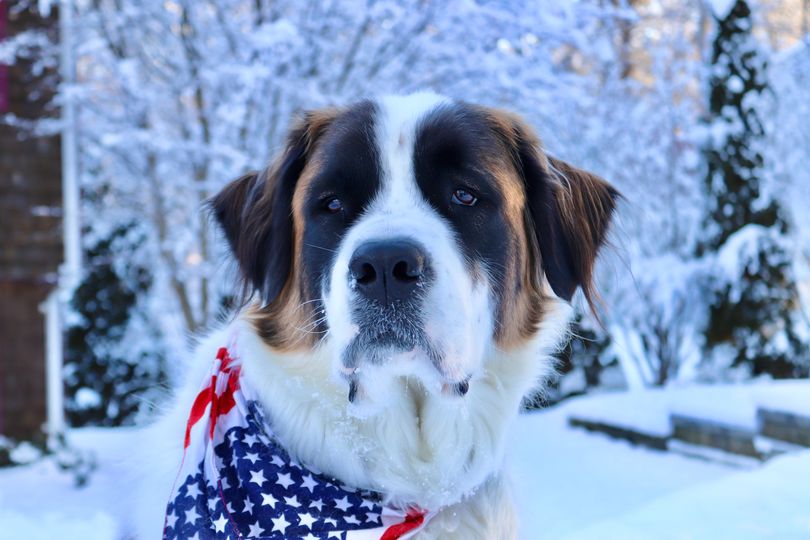Dog Breed
Saint Bernard
GiantNanny

- Full Name
- Saint Bernard
- Alternate Names
- St. Bernhardshund, Bernhardiner
- Your PupScore
- Take the best dog breed quiz to get your Pup Scores!
- Life Span
- 8 - 10 years
- Weight
- 130 - 180 pounds
- Description
A genuine friendly giant, the Saint Bernard is known as a "nanny" dog that will naturally want to babysit babies and small children all day long. They were initially bred for rescue missions in the Alps, where they would often need to pull heavy gear through thick snow. They are still large, imposing, good in cold weather, and love working and pleasing their owners. In fact, they are still used as rescue dogs and service dogs due to their calm nature and desire to serve and help others. They are adorable, want to please everyone, and have a heart as big as they are.
- Origin
- Switzerland
- Bred For
- Rescue missions in the alps
- Family Considerations
- Overall Ease of Breed
- Personality
- Home and Environment Considerations
- Physical Characteristics
Child Friendly
5/5
Is the Saint Bernard good with children?
Yes! The Saint Bernard is naturally friendly with children. As always, socialization is always important, but the Saint Bernard is an excellent dog for anyone with small children.
Stranger Friendly
5/5
Is the Saint Bernard friendly with strangers?
Yes! The Saint Bernard is naturally friendly with everyone. As always, socialization is always important, but the Saint Bernard typically loves everyone they meet
Dog Friendly
5/5
Is the Saint Bernard friendly with other dogs?
Yes! The Saint Bernard naturally loves other dogs. As always, socialization is always important, but the Saint Bernard typically gets along with every dog it meets
Likes to Cuddle
4/5
Does the Saint Bernard like to cuddle?
The Saint Bernard appreciates affection and that includes kisses and snuggles!
Playfulness
4/5
Does the Saint Bernard like to play?
The Saint Bernard will almost always be ready for play! The Saint Bernard is great for a family with children, or otherwise, an environment that is always ready for play.
Service Dog Ability
5/5
Does the Saint Bernard make a good service dog?
The Saint Bernard is a common service dog. The Saint Bernard is smart, dedicated, and patient. However, despite the Saint Bernard being an excellent breed for service work, they must pass through an extensive training period and only some will be up for a life dedicated to service work.
Ease for Novice
2/5
Is the Saint Bernard good for first-time owners?
The Saint Bernard would not be the best fit for first-time owners. A breed is only good for first-time owners if it is raised for home companionship, and is open to training and is motivated to please its owner.
Training Potential
3/5
How well can the Saint Bernard be trained?
The Saint Bernard is about average when it comes to training potential. The Saint Bernard can be seen in competitions and can have advanced training, but it would require much dedication and oftentimes professional training.
Amount of Shedding
4/5
Does the Saint Bernard shed a lot?
The Saint Bernard sheds a lot! They may still shed less than a few other breeds, but be prepared for dog hair throughout the home and on your clothes.
Ease of Grooming
2/5
Is the Saint Bernard easy to groom?
The Saint Bernard requires a good amount of grooming work. It is possible to do it yourself, but you need to plan on dedicating weekly grooming sessions at the minimum.
Exercise Need
2/5
Does the Saint Bernard need a lot of exercise?
The Saint Bernard requires some daily exercise, but daily walks should be enough. The Saint Bernard appreciates going outside and on daily walks, but they will be ok without anything overly athletic.
Intelligence
3/5
How smart is the Saint Bernard?
The Saint Bernard has average intelligence. They are smart and witty, but do not need to be constantly challenged mentally, as some other breeds.
Amount of Barking
1/5
How much does the Saint Bernard bark? Does the Saint Bernard bark too much?
The Saint Bernard barks very little compared to other dog breeds. This is excellent for apartment living and is very convenient for travel and otherwise when you are out in public.
Guard Dog Ability
3/5
Is the Saint Bernard a good guard dog?
The Saint Bernard is not typically used as a guard dog, although they can be alert and oftentimes notify you if there is a stranger at the door or otherwise something to be concerned over.
Tolerates Being Alone
2/5
Is the Saint Bernard good at staying alone? Is the Saint Bernard independent?
The Saint Bernard is not very independent and does not do great when left behind for longer than a couple of hours. This is one of the most important things to consider when getting a new dog.
Good for Apartment Living
3/5
Is the Saint Bernard a good apartment dog?
The Saint Bernard is not the best dog apartment living, but it can work if the owner is dedicated to exercising and training their Saint Bernard
Size
5/5
How big is the Saint Bernard?
The Saint Bernard is one of the biggest dog breeds in the world. In the "giant" category!
Tolerates Heat
1/5
How much does the Saint Bernard tolerate hot weather? When is it too hot for a Saint Bernard?
The Saint Bernard does not tolerate hot weather at all, and we would not recommend having a Saint Bernard if you live in a hot weather climate.
Tolerates Cold
5/5
How much does the Saint Bernard tolerate cold weather? When is it too cold for a Saint Bernard?
The Saint Bernard does very well in cold weather, and loves the snow. They were built for it!
Potential to Run Away
1/5
Does the Saint Bernard try to run away?
The Saint Bernard is very unlikely to run away. Of course, precautions should always be taken, and every dog is unique, but with a Saint Bernard it is very likely they will naturally follow you, even when they are off-leash.
General Health
3/5
Is the Saint Bernard a healthy dog? The health of a Saint Bernard should be measured not just by how many years they live, but also by how many health issues they've had. It is important to know which health conditions your breed is prone to- hip problems, eye problems, bloating, and arthritis are all common dog health problems.
The Saint Bernard is healthy, but has an average number of health risks that should be taken into consideration.
Energy Level
2/5
How energetic is the Saint Bernard?
The Saint Bernard has some energy and requires daily walks, but overall the Saint Bernard has less energy than average.
Amount of Drooling
5/5
How much does the Saint Bernard drool?
The Saint Bernard is one of the dog breeds that drools the most. It may not be the most important factor, but something to consider if you live in a home where that may bother you.
Prey Drive
2/5
Does the Saint Bernard have a large prey drive? Does the Saint Bernard like to chase birds, cats, and other small animals?
The Saint Bernard has some prey drive, so should not be left alone with very small animals such as birds, mice, or gerbils, but with some gradual introduction should be fine living with a cat in the same home.
Athleticism
2/5
Is the Saint Bernard atheltic?
The Saint Bernard can have athletic moments, and bursts of speed, but does not have the endurance as other highly athletic dog breeds. They would do great for occasional jogs, but probably not the best for long-distance runs or anything more athletic than that.
Breed Variations
Short-coated
Long-coated
 Dog
Dog- Working
- Mountain Type
- Saint Bernard
The Saint Bernard is a purebred dog that belongs to the Mountain Type sub group, which falls under the larger Working dog breed group.
Working group: Working dogs encompass a wide range of different breeds- but they all were bred to assist people, so they are used to working hard. It is important for them to feel they have a "job" as their roles traditionally have varied from rescuing people to pulling sleds.
Because of their large size and intensity, they may be a handful for first time dog owners. On the other side, they can be trained well, so any owner who can exercise and dedicate to training their working dog, will be well rewarded. A common misconception may be that the working dog's jobs are only in physically challenging jobs; actually working dogs can also make excellent service dogs, since they are also kind and attentive to their owners.
Mountain Type sub-group: Mountain type dogs are rustic, powerful, and majestic. They are not a good dog for first time owners since they are demanding, and need an owner who they can respect and appreciate. Of course they need loving just like any other dog, but they are unique because they have these additional "expectations". In addition, mountain type dogs want to feel they always have some sort of "job" to do since they were bred to either protect a property or flock.
Mountain dogs are similar to livestock guardian dogs in many ways, but have been raised on the mountains, and typically are better suited for extreme weather conditions, particularly cold weather. Mountain dogs are not always friendly with strangers or other dogs, since they are used to being in charge, and are protective. However, with family and small children they can be extremely loving, and enjoy a night cuddled up alongside you. Mountain Dogs bark a lot and love being outdoors, so they are probably the worst dog for an apartment.
Saint Bernards for adoption
Similar Breeds

